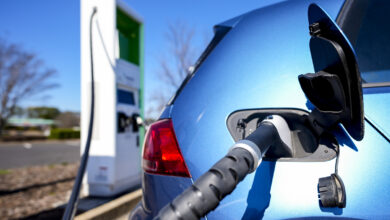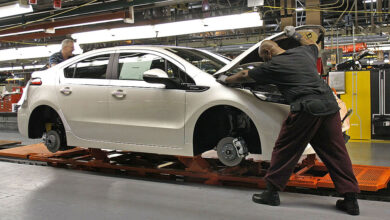Electric Vehicles Not Guilty Of Excess Short-Term Fire Risk Charges

Car carrier Fremantle Highway off Eemshaven, on August 3, 2023 as it is being towed to a new … [+]
Electric vehicle cognoscenti can breathe a sigh of relief. Comprehensive data now shows EVs are much less likely to burst into flames than internal combustion engine vehicles, according to experts.
Next-generation EVs using sodium-ion batteries are even less likely to ignite spontaneously. Long-promised solid-state power will, eventually, be even safer. Sodium-ion power has another benefit. Sodium-ion batteries can be transported with zero volts on board, so catastrophes like the Felicity Ace transport ship destruction by fire will be a thing of the past.
The fire on board VW’s transporter from Germany to the U.S. a couple of years ago carrying almost 4,000 vehicles, including EVs like the Porsche Taycan, Audi e-tron and VW ID.4, was allegedly started by lithium-ion battery fires. The cargo was valued at the time at $438 million and lawsuits are currently underway concerning liability. Lithium-ion batteries must always carry some electrical charge to avoid degradation.
So that’s a clean bill of health then?
Not quite. Electric cars have been ubiquitous only for about 5 years so the data can’t make an ICE/EV comparison for longer than that.
The scare about EV fires was whipped up by media coverage showing various expensive Teslas going up in flames after accidents, or for no particular reason. The implication was that this was somehow typical of EVs. The data now shows this isn’t the case, yet. The trouble is it would take a lot to make an ICE car in flames a headline story. “ICE Car Fire Sets White House Alight” might do it.
The media has also shown some scary-looking fires started by electric scooters parked overnight indoors. This highlights another problem arising from poor quality cells used on these very cheap vehicles entering thermal runaway.
The fires did highlight a serious problem for EVs. When battery fires do start they are much harder to put out than ICE ones. Fires can burn for days and often reignite when the fire seems defeated. Fire-fighters are trained to use total immersion in a swimming pool-like structure to make sure the fire is out.
Six Teslas burn on the trailer of the truck carrying them after one catches on fire due to unknown … [+]
“The overall arching takeaway (from the data) is that the rate of fires happening is less for EVs than petrol or diesel cars, and quite substantially,” said James Edmondson, Research Director at Cambridge, England-based independent researcher IDTechEx in an interview.
Edmondson said various surveys showed EVs represented far less of the reported fires than might be expected given their market share. Estimates by the Phosphorous, Inorganic & Nitrogen Flame Retardants Association reported 55 fires per billion miles travelled in ICE vehicles and five fires per billion for EVs. A report from AutoinsuranceEX said EVs exhibited 61 times fewer fires per 100,000 sales than ICE vehicles.
“Tesla has reported that between 2012 and 2021 there was approximately one Tesla vehicle fire for every 210 million miles travelled. This includes fires that did not originate in the vehicle, like arson, structure fires etc. According to the National Fire Protection Association, the national average in the U.S. was one fire per 19 million miles travelled. This suggests Tesla’s EVs are 11 times less likely to catch fire than the average car,” Edmondson said.
But Edmondson cautioned about the age comparison.
“Most EVs on the road are quite new and many of the vehicle fires in ICE vehicles will relate to old vehicles where components wear out. This could be equally true for older EVs as the battery cells age and the materials used around them to provide thermal management, protection, and fire safety,” Edmondson said.
“The switch to sodium-ion from lithium-ion could be another solution to reducing the risk of fires. Despite the fact that this type of battery still comes with a risk, early studies report a lower chance of thermal runaway. Their ability to be transported at zero volts makes them lower risk than lithium-ion when considering transport and assembly,” Edmondson said.
Solid-state batteries are also less likely to overheat.
Solid-state battery pack design for electric vehicle (EV) concept illustration, 3D rendering new … [+]
GlobalData automotive analyst Oliver Petschenyk said lithium iron phosphate batteries (LFP) are becoming more popular because they are cheaper than lithium-ion, offer much more useable life, and considerably higher safety.
“A battery is only as good as its battery management system. A good BMS takes into account battery temperature throughout the pack, monitors charge and discharge rates and can isolate any cell that reaches its max/min SOC (state of charge),” Petschenyk said in an email exchange.
“It provides cell voltage leveling which ensures all cells are within a certain voltage of others, preventing localized voltage spikes or overcharging of failing cells. Effectively, it keeps the battery within its ideal and safest operating conditions. Typically, cheap electric scooters have poor BMS or even no BMS,” Petschenyk said.
London underground notice banning e-scooters and e-unicycles, London, UK. The tube network banned … [+]
Petschenyk agrees sodium-ion offers similar advantages to LFP, but adds reduced operating voltage, lower energy density, less cost, and longevity, plus the ability to be transported fire-risk free.
Petschenyk and Edmondson both agree that solid-state batteries will add an extra layer of safety, and that despite protestations to the contrary will not make an appearance in mass-market EVs any time soon. Solid state will appear first in some high-performance premium vehicles and will trickle down to most EVs no earlier than 2030, they say.
The industry, and EV buyers, have a while to wait for solid-state technology to be mature enough for mass production. The promises are it will halve the weight and price, double the range, and provide lightning-fast charging.
Cynics will recall the famous phrase – “if it sounds too good to be true it’s probably not true”.



